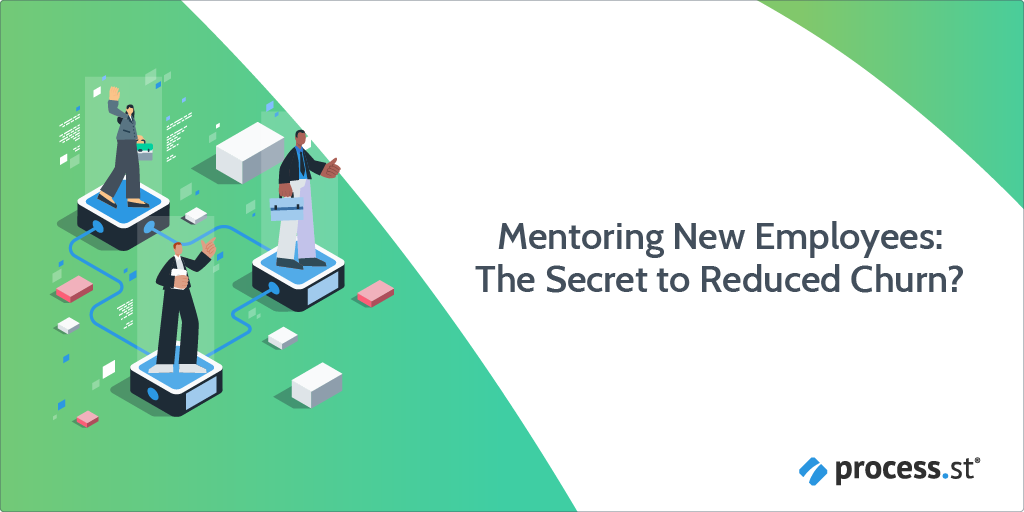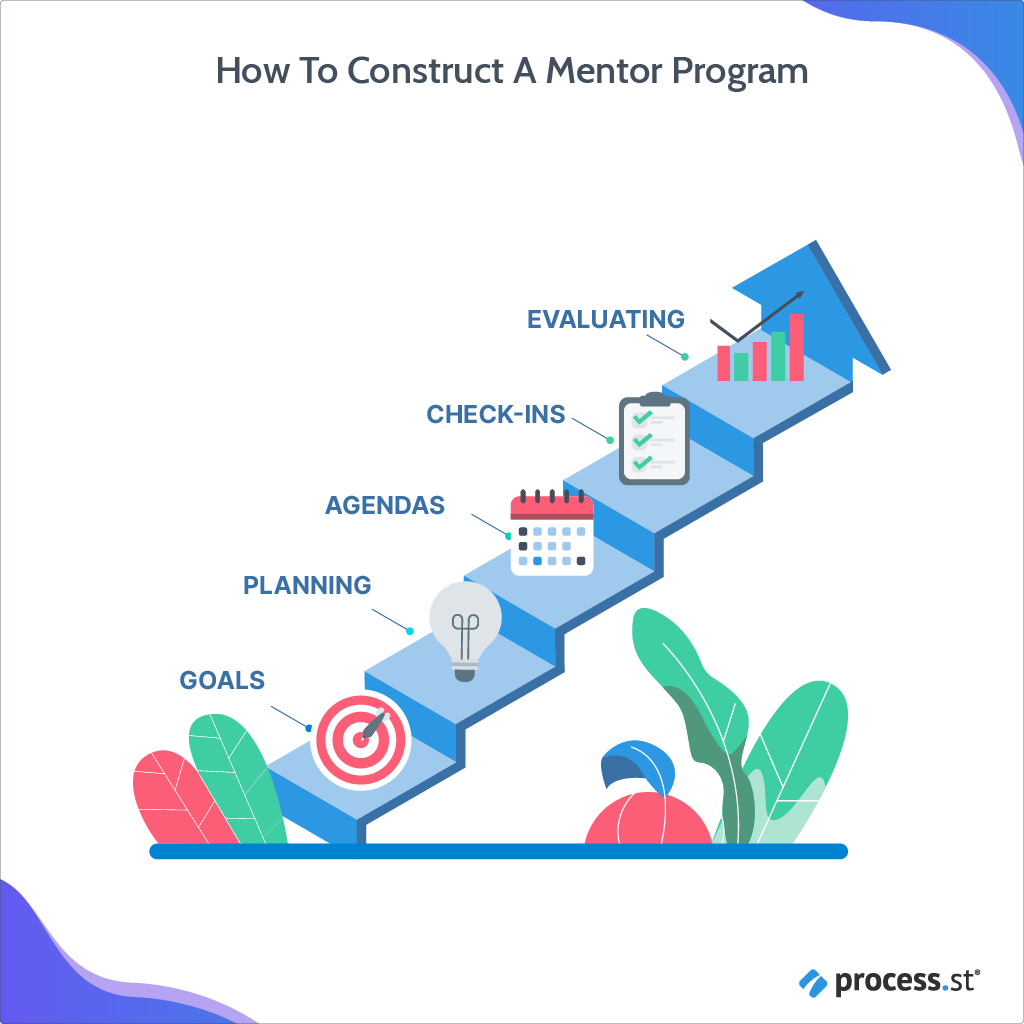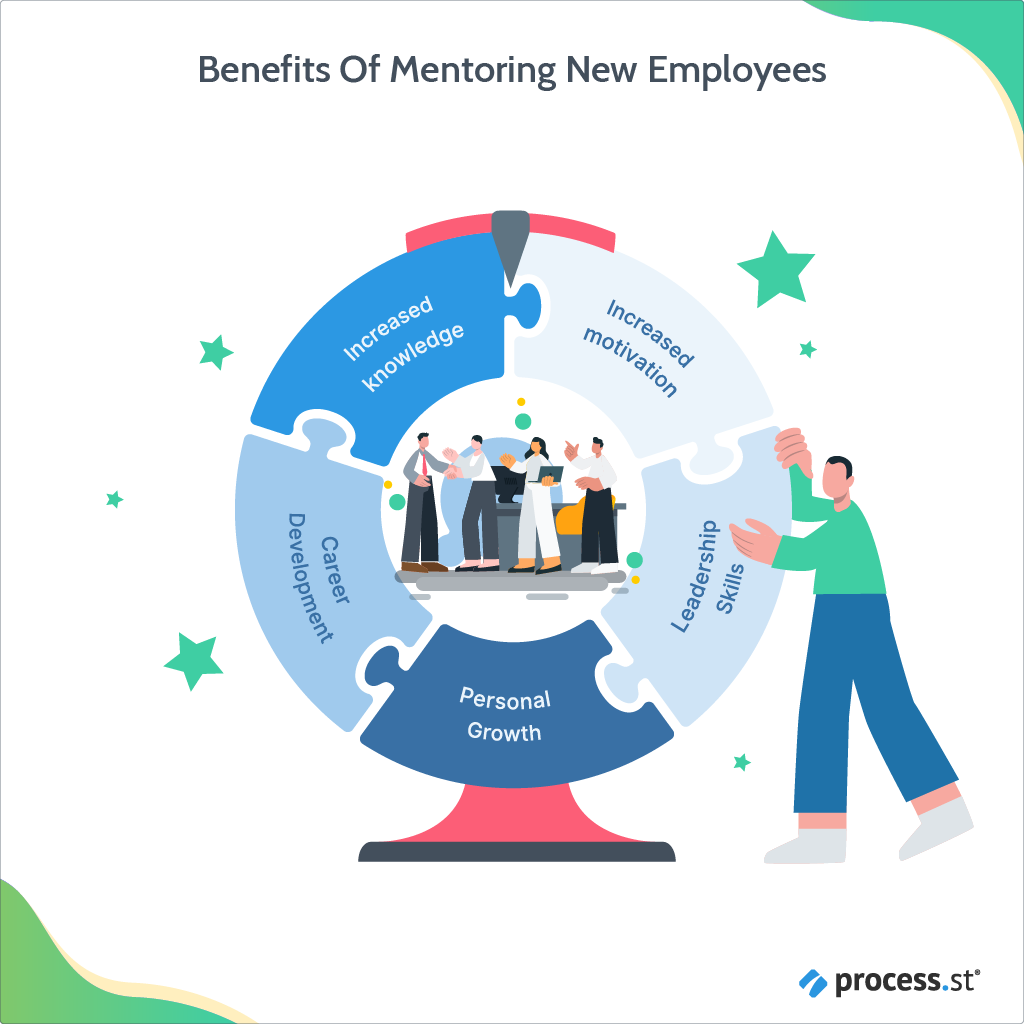
Mentoring new employees can be tricky.
Think back to a time when you stepped into unfamiliar territory. Can you remember how intimidating it was? That’s the dilemma each new employee faces.
They need to acclimatize to a new culture, a new team, a new role, and new responsibilities. It’s daunting having to walk into an environment where everyone except you knows what they’re doing.
Mentors are responsible for offering a support base for the new hire to get settled in their role quicker. These mentors use their past experiences to offer sound guidance, helping build the new employee’s confidence and skills from the get-go.
Mentoring new employees happens during onboarding, but how can you make the most of it? In this Process Street post, I’m taking you through the mentoring program and how it can be your secret weapon to reduce new hire churn.
- Why mentoring is important in the workplace
- Investing in a mentoring plan for new employees
- How to make the most out of training and mentoring new employees
- The role Process Street plays in mentoring your new employees
- From mentee to mentor
Follow me to the mentoring machine!
Why mentoring is important in the workplace
To flourish in an organization, employees need friendships.
Research has found that employees with close relationships with their co-workers are 50% happier. This research also showed that such employees are 7x more engaged than those lacking close relationships in the workplace.
When you’re mentoring your new employees, you’re already helping foster these close relationships. A mentor program builds connections with co-workers from their first day and cultivates deep relationships for future collaboration.
Mentoring new employees makes them feel like part of the team from the get-go. These new workers are part of a buddy system that helps them integrate into the company culture quicker and feel more comfortable in their roles.
One of the key roles of a mentor is to get the new hire oriented with their responsibilities and the department they’re working in. This mentoring program is especially important for remote and hybrid working environments.
With the help of a mentor, new employees feel more confident in their positions, making them more productive faster. The mentor’s expertise and knowledge can also rub off on the new hire, allowing them to acquire new skills.
Overall, the mentee’s professional development is boosted and their confidence in their current role grows. All of these lead to greater retention while building a valuable foundation for employee development.
Investing in a mentoring plan for new employees
When you invest in a mentoring plan for your new hires, you’re:
Introducing them to your company culture
When you’re onboarding a new hire, they need to develop a good understanding of your culture. Having a mentor assigned to your new employee helps introduce and integrate them into your organization.
Without a mentoring plan, your new hire would need to figure this out on their own. That would take a lot of time and effort.
Instead, the mentor can offer guidance through their experience, empowering the mentee to focus more of their efforts on being productive in their role.
Improving retention
Research shows that retention rates were higher for employees (72%) with a mentoring plan than those without one (49%).
Gallup also found that 94% of participants appreciated having a mentoring program included in their onboarding experience.
It’s clear to see that a mentorship is a powerful tool for boosting retention in an organization.
Inspiring loyalty
A new employee already feels special about being chosen to join your team. You can build on these feelings by providing a mentoring program. It showcases your eagerness to invest in them and offers a supportive environment for them to grow.
When you’re giving them this attention during the onboarding process, you’re showing them that they’re valued by you and your team.This helps in boosting organizational commitment and loyalty.
Making them productive quicker
Getting up to speed with their new responsibilities is another benefit of investing in a mentoring plan. These mentees will have someone show them the ropes, helping prevent confusion.
When you assign them to a mentor, you’re giving them someone they can rely on while they familiarize themselves in a new position. This also means they have someone they can go to when they have unanswered questions.
Having this clarity and support helps them spend more time on their job rather than introducing themselves to the unfamiliar protocols associated with being a newbie.
How to make the most out of training and mentoring new employees
You can only reap the benefits of assigning your new employee to a mentor if you’re enforcing a solid plan.
I’ve outlined some best practices to help you get started:

Set the goals
The first step to developing a good mentorship plan is to define the goals you wish to achieve. During this phase, you want to look at what skills you want your new hire to develop.
Keep in mind that you want these skills to align with their development path. Highlighting these objectives early on will help you align these with your overall organizational goals.
Getting the pairing right
Pairing your new hires with an appropriate mentor is one of the most crucial steps when crafting a great mentoring relationship. You want to develop a system that determines which mentee gets paired with a specific mentor.
Different methods can be used to get a good mentor pairing, but what would a good match look like?
You should consider these questions when connecting your new hire to their mentor:
- What expectations do both participants have?
- What outcomes do they believe they need to have for it to be a successful mentorship?
- Do you want to connect the hire to a mentor with experience or skills this new employee wants?
- Is it important for the participants to have specific similarities (like career background, interests, or communication style)?
Expanding your mentoring program can make pairing time-consuming. Mentor-matching software can help you streamline the experience without negatively impacting who gets paired with whom.
Sticking to the agenda
You want to offer assistance during this mentoring relationship. Providing resources like TED talks, articles, ideas for discussion topics, or sample questions can help guide both participants during their mentoring sessions.
By creating an agenda with these resources, you help break the ice between the mentor and mentee. You’re also ensuring that each session can be utilized efficiently.
One of the best agendas to have for the first meeting is to have both participants write up a plan for their mentoring sessions. Here they can agree on logistics like how they’ll prepare for each of their meetings and what times will be best. Expectations can also be outlined in this plan so that the mentor and mentee know what they are responsible for.
Make sure to check-in
Your work isn’t over once you’ve paired the mentor with the mentee and given them an agenda and resources. It’s also important to create a plan to connect with them before the mentorship starts, once it’s wrapped up, and also during the experience.
During these check-ins, you can ask for their thoughts on the experience. You can refine your mentoring plan by finding out what worked well during their experience, and what didn’t.
Checking in also helps you resolve any issues that might come up during the experience. For example, a mentee might wish to switch their mentor. If you’re checking in, you can make this change and also understand the reason behind it.
Evaluating the performance
How do you know if your organization’s mentoring program is successful?
First, you can look back on the goals set between the mentor and the mentee. You can see if the mentoring was successful by finding out if these goals were achieved.
Asking for feedback is also a great way to test the performance of your mentoring plan. Even if the mentee has achieved the original goals set out at the beginning, there might be a few things that could have improved the experience. Knowing what these elements are can help you refine the program and get more from it.
Finally, it’s important to always link the outcomes of the mentoring relationship back to the onboarding process. You want to make sure the efforts made during the mentorship are contributing to the overall success of the onboarding process.
The role Process Street plays in mentoring your new employees
When it comes to creating a mentoring relationship with your new hires, tracking the progress of this experience is vital.
Seeing your new hire’s progress and the skills they are learning helps you stay on track and ensure you’re steering them towards success in their onboarding and career development.
However, this progress can become stalled when you’re relying on communication from the mentor or if the expectations around this program are unclear for all the parties involved.
Likewise, it can be difficult to understand where this mentorship plays a role in the onboarding process.
Following a dedicated template can help ensure that everyone is on the same page. The mentoring session can be included as a task in your onboarding workflow. It can include resources for your sessions, a feedback section, an approval for HR to look over the performance of the mentee, and can trigger a check-in meeting to be scheduled during different phases of the mentorship.
Use this pre-made onboarding template that includes a task assigning a mentor to help you get started. You can then edit it to the exact specifications of your mentoring plan.
From mentee to mentor
The goal of any mentoring plan is to get your new employees acquainted with their:
- Work environment
- Responsibilities
- Company culture
Achieving this gets them more productive quicker.
You boost your new employee’s career development when you assign a mentor to them. This is because they can learn from the mentor’s experience and failures. From here, you’re empowering your employees to learn from each other and also teach from their shortcomings.
With the right mentoring plan in action, your new employees are exposed to valuable mentors who can teach them the ropes quickly, so they can also go off and share their learnings with the next set of new employees coming in.
When an employee is mentored well, they can mentor well, and so it carries on. All this helps you build a workforce of top talent that’s committed to achieving your company goals and continually working towards career development.
Do you use a mentoring plan for your new employees? Let us know in the comments.







 Workflows
Workflows Forms
Forms Data Sets
Data Sets Pages
Pages Process AI
Process AI Automations
Automations Analytics
Analytics Apps
Apps Integrations
Integrations
 Property management
Property management
 Customer management
Customer management
 Human resources
Human resources
 Information technology
Information technology




Grace Donaldson
Grace is a content writer with a thirst for knowledge and coffee. You'll find her reading in a small café or singing at a rundown jazz bar when she's not overconsuming coffee or compartmentalizing her thoughts into a blog post.